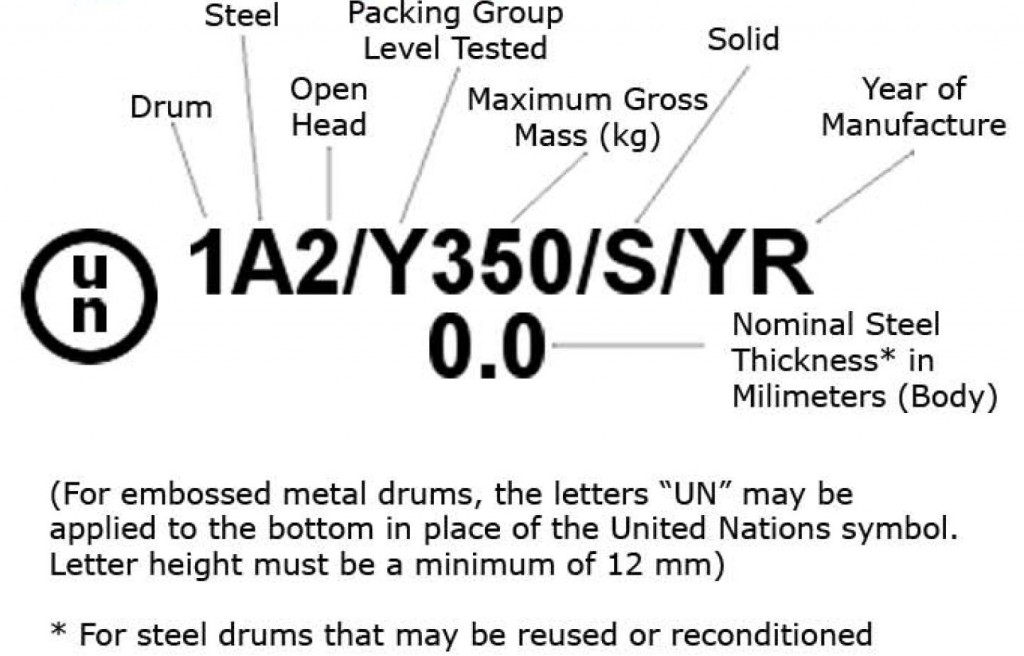——————————————
Download a copy of this alert >
——————————————
Under performance-based packaging standards incorporated into Title 49 of the Code of Federal Regulations (49 CFR §173.22(a)(2)), it is the responsibility of the person offering the packaging for shipment to specify the proper container to hold their product. The steel drum manufacturer’s responsibility is to produce a container that will consistently meet the specified performance rating. Drum manufacturers have extensive experience to share, but ultimately the filler or shipper of the packaging should determine the appropriate specifications for the container.
Performance-based packaging begins with a true understanding of the product that will be filled into the steel drum. At the beginning of the purchasing process, the following information is needed to determine the packaging that should be specified.
1. Define the product characteristics and determine if the product is regulated.
Most of the information needed above can be found in the product’s Safety Data Sheet (SDS).
You may also access 49 CFR directly by visiting www.ecfr.gov via this link: http://bit.ly/1eTlDMN.
Collect the following information from the Hazardous Materials Table found in 49 CFR §172.101 to add to the container specification chart.
- Hazardous Material Description and Proper Shipping Name (Column 2)
- Hazard Class/Division (Column 3)
- UN Identification Number (Column 4)
- Packaging Group I, II or III (Column 5)
- Special Provisions (Column 7)
- Packaging Authorization (Column 8)
Other pertinent references and definitions necessary for the specifications chart can be found at the following locations in 49 CFR:
- Specific Gravity (Liquids Only) § 178.503 (a)(4)(i)
Relative density of the material, rounded down to the first decimal.
- Net Mass (Solids Only) §178.503 (a)(4)(ii)
The total weight, in kilograms, of the material placed in the container. Container must be marked with the maximum gross mass.
- Hydrostatic Pressure Test (Liquids Only) §178.503 (a)(5)(i)
The pressure in kilopascals (kPa) that the packaging must be capable of withstanding, which relates to the vapor pressure of the lading at a specific temperature (50 degrees Celsius or 55 degrees Celsius).
2. Describe the type of container required.
3. Specify the proper container.
With product information and regulated requirements now collected, a proper container may be specified.
Note that even if the lading is not regulated, it is still the responsibility of the shipper/filler to ensure that all gaskets, interior linings, removable liners, plugs and fittings used in the construction of the finished container are compatible with the product. Inform the drum manufacturer of any changes in the lading ingredients that could affect compatibility. For more information on accessory compatibility, see Alert 14-06.
The drum manufacturer will produce containers to specification and will signify the performance rating with embossed markings on the drum. The sample markings are shown below.
- The embossed mark on the left indicates that this is an open-head steel drum that meets the requirements of a Y-rated solid product that has a maximum gross mass of 350 kg. The mark also contains the year the drum was manufactured.
- On the right is a sample of a tight-head steel drum rated for liquids. The shipper/filler should consult with the container manufacturer to determine the minimum wall thickness needed to meet the performance requirements.
Sample Marking – Open-head Drum
Sample Marking – Tight-head Drum
Note: “S” may also be used to indicate inner packagings. 49 CFR§178.503 allows for uppercase Roman “UN” without the circle in the embossment. Marks illustrated above are located on the bottom of the drum.
Beware of the tendency to require “macho-marked” containers (the X level) when your product does not call for this rating. Approximately 98 percent of all products packaged in steel drums are covered under the Y rating. While there may be some inconvenience when carrying two inventories, it may be to your advantage to purchase the majority of drums to meet your requirements at a “lower” rating. Reserve X-rated drums specifically for the products that demand this rating. Speak to your container manufacturer for more information before finalizing your selection.
4. The Role of the Container Manufacturer and Testing Considerations
When provided with your specifications, it is the steel drum manufacturer’s responsibility to create containers that best meet your needs, including supplying recommendations on minimum wall thickness and other design features.
Your steel drum manufacturer is also responsible for all certification testing of the packaging. 49 CFR §178.602(c) states: “If the material to be transported is replaced for test purposes by a non-hazardous material, the material used must be of the same or higher specific gravity as the material to be carried, and its other physical properties (grain, size, viscosity) which might influence the results of the required tests must correspond as closely as possible to those of the hazardous material to be transported.” Inform your container manufacturer if you plan to use a removable liner or require a specific gasket.
Issued 01/14
This information is based on the Industrial Steel Drum Institute’s best knowledge at time of issuance. It is the responsibility of any filler or user of steel drums and pails to ensure that the unique characteristics of products contained therein or any reformulation of products are accurately described to the drum and lining manufacturers. Customers, fillers and users should consult the appropriate professional for assistance in compliance with the responsibilities outlined hereunder.





